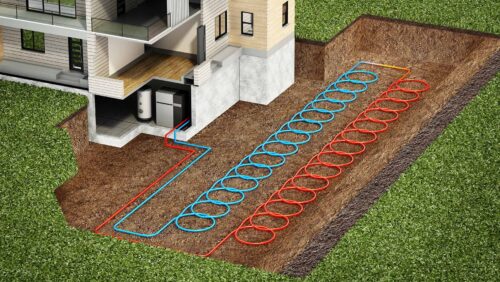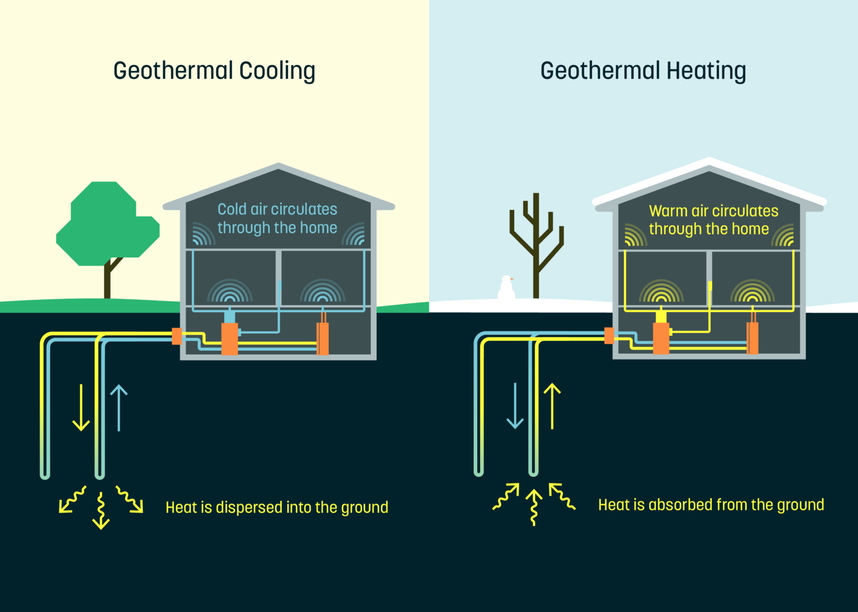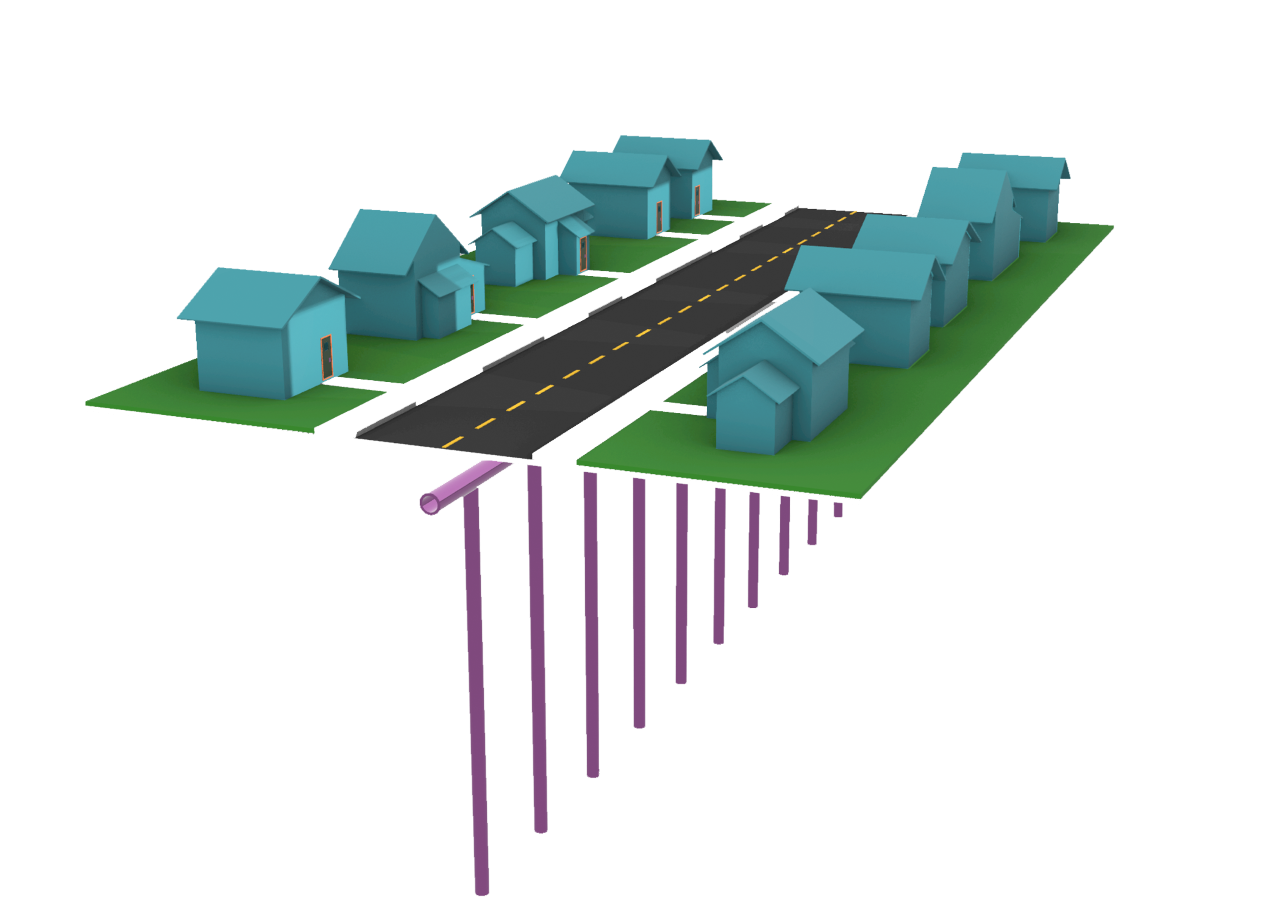
Clean Energy 101: Geothermal Heat Pumps
A time-tested clean heating and cooling technology with untapped potential.
The age of the electric heat pump is well underway. This clean heating and cooling technology has been in use for decades and is widely adopted across Asia and parts of Europe such as Norway where heat pumps heat and cool 60 percent of its buildings. However, it’s only recently that advances in its technology have spurred more home and building owners in the United States to realize the outsized economic, health, and climate benefits of going electric.
Today, the heat pump market is booming. Sales in Europe last year rose to a record high with a 37 percent increase from 2021. In the United States, heat pump sales outpaced gas furnaces for the first time in decades. With new tax credits and upfront rebates in the Inflation Reduction Act (IRA — the climate bill passed in 2022), the stage is set for further ramping up equitable building electrification. One key technology that has received less attention but has untapped potential to bring the immense benefits of clean heating and cooling to millions of people is the geothermal heat pump, also commonly referred to as a ground-source heat pump.
Geothermal Heat Pumps: The Basics
A geothermal heat pump is a clean, renewable technology that helps a home or building stay comfortable in any season. It harnesses the constant temperature below the earth’s surface to provide heating, cooling, and often hot water. Since geothermal is an abundant and renewable resource just beneath our feet, geothermal heat pumps are considered some of the most efficient, cost-effective, and environmentally friendly HVAC and water-heating systems available. And because heat pumps simply move heat and don’t rely on combustion, like a gas furnace or water heater, they can reduce energy costs by up to 50 percent and produce zero direct emissions that contribute to air pollution and climate change.

Geothermal heat pumps efficiently transfer heat stored in the ground to your home when it’s cold outside and vice versa during hotter months, providing year-round comfort and energy savings. Image: Dandelion Energy
Systems typically consist of a heat pump that replaces your furnace and is connected to pipes or a ground loop that contains heat-transferring liquid. These ground loops can be buried in horizontal trenches just below the earth’s surface or in deeper vertical boreholes, depending on location and density. The heat pump uses electricity to pull heat from the ground during colder months and works in reverse to dump heat into the ground when it’s hot out, acting as an air-conditioner. Conventional ductwork is most often used to distribute heated or cooled air from the heat pump throughout the building. Geothermal heat pumps are not geothermal power plants. Geothermal power plants produce electricity by using the heat underground to rotate a turbine, and they are primarily used for large-scale grid power, not connected homes and buildings.
Other benefits of geothermal heat pumps include reduced operating and maintenance costs, a quiet and long-lasting system with good humidity control, and less energy demand to support a more resilient electric grid. Curious if a geothermal heat pump is right for you? The Department of Energy has helpful tips for choosing and installing.
Networked Geothermal: Powering Campuses and Neighborhoods in Hot and Cold Climates

Geothermal heat pumps can be scaled up to meet an entire community’s heating and cooling needs. Image: HEET
In addition to single-family homes and apartments, geothermal heat pumps have been successfully installed at universities, hospitals, commercial office parks, and neighborhoods. They are particularly effective in network systems that connect multiple buildings through shared piping and which use energy from the ground, wastewater, and ponds, among other sources. These network systems can achieve more than 500 percent efficiency, meaning for every unit of energy that goes in, five go out. These larger systems require infrastructure to be installed and maintained, fostering local jobs and growing the clean energy economy. They can transition whole communities onto geothermal at a time, creating economies of scale that bring energy costs down for all participants. For example, a Whisper Valley, Texas, neighborhood connected 400 homes to a geothermal heat pump system, which helps to keep their homes cool during extremely hot summer days.
Geothermal heat pumps are also particularly effective in cold climates because they maintain high efficiency and high output capacity even during winter months in northern states like Minnesota. For example, an ice arena in Woodbury, MN, leveraged utility incentives and an energy efficiency block grant to install a geothermal system that keeps the ice cold and the fan section warm. The arena’s system is expected to cut its energy use in half and save more than $100,000 in annual utility costs while reducing emissions.
Be the real power behind the energy transition.
Your donation to RMI turns bold clean energy ideas into real-world solutions right when people and the planet need them most.
Better for the Climate
To look at the impact geothermal heat pumps can have on reducing climate pollution in colder climates, RMI compared appliance emissions across three Midwest utility territories. In this region, geothermal heat pumps significantly reduce emissions compared with fossil fuel appliances, producing approximately 85 percent fewer emissions than a gas furnace and 90 percent fewer emissions than a propane furnace through 2050. With on-site renewables, such as solar, or a 100 percent clean grid, geothermal heat pumps can enable buildings to reach zero operational emissions. As more renewables come onto the grid, homes and buildings powered by heat pumps will continue to have smaller and smaller carbon footprints.
Exhibit 1: Average Annual Emissions of Space Heating Options through 2050
Note: These results are based on analysis of residential heating technologies across the Midwest developed by 5 Lakes Energy over the course of a full year. Electricity emissions intensities are based on NREL’s standard electrification 95×2050 scenario.
Addressing Key Electrification and Grid Reliability Concerns
Geothermal heat pumps use about 80 percent less energy annually than industry-standard fossil fuel furnaces to heat homes in the Midwest. They use four times less electricity on the most extreme cold days than air-source heat pumps and can support limiting peak demand on the utility system during cold snaps or heat waves.
Exhibit 2: Annual Energy Demand of Space Heating
Note: These results are based on analysis of residential heating technologies across the Midwest developed by 5 Lakes Energy over the course of a full year
Recent Federal Legislation Lowers Costs
Although geothermal heat pumps are typically more expensive for home and building owners to install, the Inflation Reduction Act has created tax credits, grants, and rebates that will significantly help drive down upfront costs. For example, the 30 percent federal tax credit paired with electrification rebates can decrease household geothermal project costs by up to 50 percent, saving as much as $15,000 for higher-cost installations. And the Investment Tax Credit can help commercial buildings, like schools, reduce upfront costs by 30–50 percent for a geothermal heat pump. Effective implementation of the new federal funding can help boost the geothermal market and reduce upfront costs even further.
To facilitate wider adoption of geothermal heat pump technology, the operational costs must be affordable as well. RMI analysis found that the cost to operate a geothermal heat pump is already low in the Midwest compared with other heating sources. With electric heating rates, geothermal heat pumps could operate at less than half the cost of natural gas and propane furnaces in this region.
Exhibit 3: Operating Costs of Space Heating
Note: These results are based on analysis of residential heating technologies across the Midwest developed by 5 Lakes Energy over the course of a full year
Key Opportunities
Higher upfront costs of geothermal can be alleviated in dense urban and suburban areas where network systems allow participants to benefit from lower utility bills while spreading out the upfront costs, so individuals pay less. Alongside geothermal heat pumps, air-source heat pumps are cost-competitive, emissions-reducing, electric alternatives to fossil fuel furnaces. To support the geothermal heat pump market, states can take actions in the following ways:
- Monetary Incentives: Designing consistent monetary incentives that promote highly efficient technology, like geothermal heat pumps, can lead to more holistic solutions that decarbonize buildings, provide cost savings, and lower emissions. Monetary incentives include tax credits, grants, rebates, and low-interest financing options. For example, the 30 percent geothermal heat pump incentive from the 25D tax credit boosted by the Inflation Reduction Act provides a 10-year consistent market incentive.
- Enabling Policies: Government policies related to building decarbonization can unintentionally exclude geothermal heat pump technologies. Consequently, climate action plans, decarbonization targets, and mandates might leave out geothermal as a part of their solutions. Policies need to explicitly include geothermal heat pumps as a viable solution to clean heat infrastructure. In Colorado for example, CO SB22-051 acknowledges geothermal/ground-source heat pumps among other technologies as applicable to income tax credits.
- Targeted Community Transitions: As more locations pass electrification policies and heat pumps become more competitive with fossil fuel appliances, it can lead to declining gas consumption and fewer gas ratepayers. Despite indications that gas infrastructure is becoming a higher risk investment, gas utilities continue spending billions of dollars to expand or repair gas infrastructure. For example, New York State’s gas utilities have spent $5 billion since 2019 on capital investments and pipeline replacement plans, while state climate legislation mandates emissions reductions in the buildings sector. Geothermal heat pumps are a non-fossil fuel alternative that gas utilities can invest in today, instead of gas infrastructure that risks becoming a stranded asset, to support a guided transition toward decarbonizing buildings.
- Pilot projects: Although geothermal heat pumps are a proven technology, pilot projects can explore the benefits of alternative financing or ownership models and utilize metering equipment to publish open-access data. Example pilots for heat pump technology include NYSERDA Community Geothermal Heat Pumps Pilot Program, Eversource’s utility-scale geothermal pilot program in Massachusetts, and the New Jersey Clean Heat Beneficial Electrification Pilot.
In a nutshell, geothermal heat pumps and network geothermal systems are a win today for households, businesses, and communities across the United States. They deliver energy savings and comfort, reduce climate-warming pollution, and create jobs. Those benefits will only increase as the electric grid gets greener and more people require clean heating and cooling solutions. Geothermal heat pumps are a part of the solution to ensure every building is healthy, affordable, and decarbonized.
